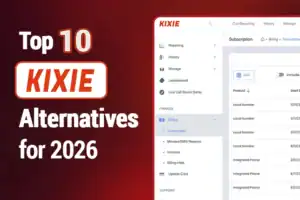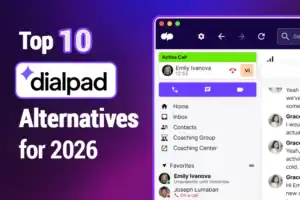If you’re running a call center, you know that good call routing is the difference between keeping your customers happy and having them hang up on you. The first thing to know about call routing is that it is the process of taking inbound calls and directing them to the people or teams who can best handle them.
Call routing lets you make sure that every customer gets their questions answered quickly and efficiently, while also making it more likely that they’ll return to your company in the future.
Call routing is an effective approach for improving customer service efficiency. The technique of forwarding an incoming call to a specified contact person is known as call routing. The latter will be able to better attend to the demands of the caller. In this scenario, it’s about providing the appropriate support to each caller.
In this article, we explore the nature, functionality, and benefits of call routing for call routing for contact centers.
What is call routing in a call center and how does it work?
The technological mechanism that automatically sends an incoming call to the correct recipient is known as call routing. A numbering strategy and redirection rules are used to accomplish this. Call routing technologies, in other words, ensure that each request is managed optimally, regardless of call volume.
How does it work?
 Good call routing software lets you set up rules for how different calls are routed depending on factors like what time of day those calls are received, which agent receives the call, how long customers have been waiting on hold, and more.
Good call routing software lets you set up rules for how different calls are routed depending on factors like what time of day those calls are received, which agent receives the call, how long customers have been waiting on hold, and more.
The call is routed to an interactive voice response technology, or IVR, as the first stage in the process. Through a sequence of automated questions and responses, IVR systems can ascertain the intent of the caller.
- Queueing Phase: The replies of the callers to the IVR will subsequently be sent to the automated call distributors (ACD) for queueing. Inbound calls can be queued by the ACD depending on the question, skills, or waiting time. Priority will be determined by the routing rules you have up.
- Call Distribution: After the calls have been queued, they will be forwarded to your agents. The call distribution technique, like the queueing process, is governed by your rules. For example, you may select the talk-time distribution technique and the routes to use.
For example:
If a customer calls your company with a question related to billing, then they would be directed to your payment team. If they have a technical question about one of your products, then they would be routed to your tech support team.
It’s important to note that—if set up effectively—call routing can save companies thousands of dollars each year by reducing wait times for customers, increasing productivity and efficiency, and preventing misdirected calls.
How does call routing work with IVR?
An IVR, or Interactive Voice Response, is linked to a phone number. As a result, you’ll be able to provide a fully configurable switchboard with a plethora of options. You may modify the organization of your customer service or call center to the demands of your users with only a few clicks.
Depending on your goals, call routing and redirections can be done using various parameters. Call routing technologies let your consultants work more efficiently. Furthermore, this technique enables you to provide a consistent client experience.
An IVR may identify the caller, qualify the request, prioritize the call, and transfer it to the most qualified agents or departments to address the inquiry. Because each call is contextualized, certain low-value-added but time-consuming calls may be managed automatically.
As a result of call routing, there will be no more unjustifiable phone wait time. Your consumers will be able to contact the appropriate department without being handed from one agent or one platform to the next.
What are the advantages of call routing for call centers?
Call routing is the process of connecting a caller to the most appropriate agent during an inbound call, and it’s a crucial component of your call center performance. Without a proper call routing strategy, you’re likely to see an increase in this trio of trouble:
- Abandoned calls
- Long wait times
- Disgruntled customers
Routing calls to the most appropriate agent for the job will take your customer experience to the next level. Your customer service agents will be able to increase performance, productivity, and more by creating a more efficient procedure in which consumers are directed to the appropriate person. And here are the advantages of call routing:
Improved customer experience and engagement
Contact centers may ensure that their clients are constantly serviced by competent agents who have the ability to properly handle caller concerns by adopting skill-based routing.
Because your contact center is a vital touchpoint for most consumers, coaching agents to develop specific skills may help your company score better in NPS surveys.
Call routing can ensure that customers are connected with an agent who is best suited to help them—for example, if the caller speaks Spanish and you have Agents who speak Spanish available at that time, they will be connected with one of those Agents. This ensures that customers don’t have to wait on hold while they’re transferred between Agents who don’t speak their language or who don’t understand their needs as well as others.
Call Routing personalization
A call routing system allows you to change the parameters to improve the client experience. You have total control over how your call management system is configured for your business and your specific caller profile.
Enhanced call center agent productivity
Your initial call resolution rate improves when you move calls based on agent expertise. The ability of call center agents to address issues and inquiries on the first call with a client is measured using first call resolution. Skill-based routing routes calls to agents with relevant experience using technologies like the Automatic Call Distributor. This guarantees that your agent and call center operate at peak efficiency.
If every caller is routed to an Agent who can solve their problem effectively and efficiently, then the call center’s overall productivity will improve. Not only does this mean less time spent resolving customer issues by each individual Agent, it means happier customers—which will improve retention rates as well as referrals from satisfied customers!
Performance management
The skill-based routing goes a long way toward increasing your call center agent’s productivity and effectiveness. Agents spend less time on each call when calls are assigned to them based on their credentials and expertise, allowing them to assist more individuals each day.
Call routing can help you get a better idea of which agents are best suited for different kinds of calls, so you can manage their performance more effectively. This makes it easier for you to understand which Agents are ready for promotion or need additional training to be as effective as possible.
Agent training isn’t as extensive
While all of your agents should be trained to handle any circumstance, certain agents will always be better at handling some specific problems than others. This allows agents to receive less training on abilities they don’t utilize frequently.
What are the types of strategies for call routing?
 How do you swiftly transfer client calls to the appropriate person? How do you keep your clients from complaining about waiting, phoning rivals, or getting transferred to the wrong department?
How do you swiftly transfer client calls to the appropriate person? How do you keep your clients from complaining about waiting, phoning rivals, or getting transferred to the wrong department?
Using suitable call routing algorithms in your IVR may increase customer interactions while also decreasing high contact center expenses and ensuring that your customers’ calls are addressed by the right person in the least amount of time.
Depending on your contact center needs and the needs of your users, call routing can take many different forms. It’s worth noting that these routing strategies can be combined to meet any request and adapt to your company’s needs. Routing tools make it simple to produce a professional and personalized phone greeting. Let’s look at the most common types and strategies of call routing:
Direct Routing
This is the most straightforward call routing for call centers Each department in your organization has its own phone number, and it is the customer’s responsibility to dial the appropriate number. They can, for example, phone the sales department to speak with a salesman.
Although this solution is straightforward to deploy, it entails a high volume of client contacts and might result in long wait times if the department is already overburdened.
Routing by Location
Even if you operate several branches or a franchise, geographic call routing allows you to keep a single, easy-to-remember phone number. Depending on how your network is set up, you can utilize a single national number or numerous local ones.
Calls are directed to the nearest branch, or from the most relevant branch, after providing an area or a postal code.
Call Routing by business hours
When you use an IVR as a call routing tool, you may build up a redirection system based on your business hours or presence. Calls are routed to available contact center agents during your business hours. The IVR sends a message in the evening, on weekends, or on holidays, stating the hours of availability, or even the times of least affluence.
Routing based on location
Determine where your customers are calling from using geographic call routing. Each call should be routed to the nearest branch from a single national number. Typically, the IVR will prompt the caller to input or name his ZIP code. Also, it is very handy for contact centers with several locations or franchise networks.
Calls are routed based on the purpose of the call
Routing software can qualify requests by asking questions from a tree menu. Allow the user to select from a list of alternatives to determine the cause of the call. After this automatic qualifying in self-care mode, the call can be forwarded to the selected service right away.
Skill-based routing for contact center agents
The call can be routed by affinity once it has been qualified by your routing tool. With a personalized IVR, you’ll always know who’s calling and why. The call is routed to the most qualified adviser available, or one who speaks the user’s native language. This call management enables your agents to specialize more, resulting in a boost in abilities that benefits everyone.
Caller ID-based routing
The IVR can tell you how many consumers you have. As a result, each new call will be identified. This allows you to categorize your consumers and give special attention to the ones who are most loyal.
In addition to identifying the call, modern routing tools may link it to your customer knowledge base. The counselor can check the history of previous discussions when the call is answered. As a result, he possesses all of the necessary components to offer the required response in a tailored manner.
All of these call routing criteria may be changed in real-time to react to market and customer behavior changes. Simplicity is key: an IVR shouldn’t force your clients to make several decisions with no clear conclusion.
Conclusion
It is now simple to set up a routing tool. Simply connect an IVR to a phone number. Today’s solutions provide you with unrivaled versatility when it comes to controlling your business challenges. Any call may be routed to the terminal of your choice. This is another step in the direction of greater mobility and agility in the contact center industry.
Automation helps you to save time for your customers and increase team productivity. You may also provide a fantastic client experience by using call routing. Individualized services are provided to your frequent consumers. Calls from prospects or clients are directed immediately to the appropriate person without the need to wait.
At NobelBiz we have 20 years of experience delivering comprehensive and tailored solutions for contact centers all around the world. Our telecommunication services and cloud contact center solution can meet the needs of all types of contact centers, regardless of size, industry, or activity (Inbound, Outbound, or Mixed). That is why we have earned a reputation as the industry’s promise keepers.
Our Cloud Contact Center Solution, NobelBiz Omni+, can integrate all communication channels (phone, social media, webchat, and SMS) into one platform. This will give your consumers and agents a seamless and exceptional customer experience.
If you want a contact center telecommunications solution, NobelBiz’s voice carrier network is constructed on a highly redundant architecture that ensures every call is delivered without interruption.
Furthermore, with worldwide coverage and redundant servers that provide 99.99 percent uptime, our voice carrier network is one of the most advanced accessible for call center voice services

Abdelmounim Benharouga has always had a strong passion for writing and digital marketing. He started as a Digital Content Writer part of marketing department then moved to being Customer Success Manager for the African Region within the Nobelbiz team.





